Laser rangefinders: features and selection rules

Laser rangefinders are popular tools and are very popular with both professional builders and DIYers. The devices replaced the traditional metal tape measures and immediately took their rightful place in the modern market of measuring instruments.
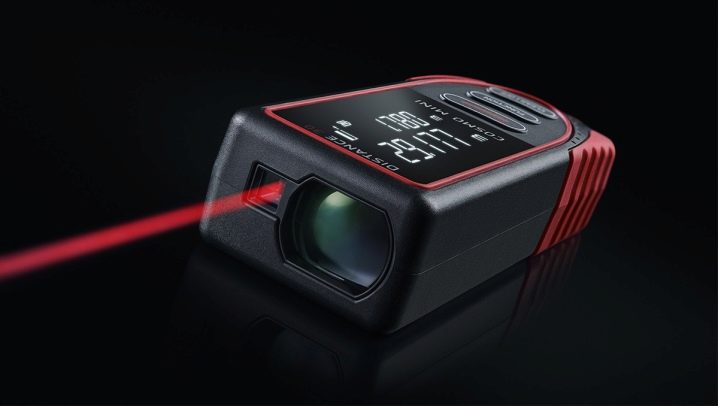
Features of the device
The laser rangefinder is a particularly accurate measuring tool that measures hard-to-reach structural elements and determines their area. Due to their wide functionality, rangefinders are widely used in various fields: construction, where they measure the distance between vertical and horizontal surfaces, calculate the area of the premises and calculate their volume, determine the length of the roof slope and the angle of their inclination, and also find the area of inclined walls and the length of their diagonals. Moreover, the rangefinder ruler is capable of working with significant areas and sizes, which is why it can be used not only in construction, but also in hunting. Hunting models have a monocular design and are capable of calculating the distance of a target with a distance of up to 2 km, while displaying the result in the eyepiece.
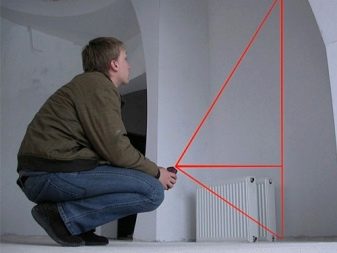
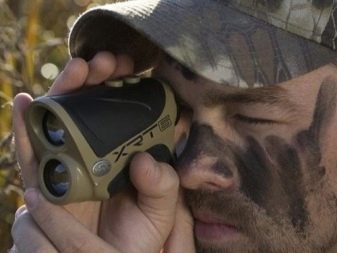
The devices are often equipped with a ballistic calculator that can accurately calculate the speed of a moving animal. However, they are not suitable for construction needs: the measurement error is plus / minus a meter, which is absolutely unacceptable for indoor work. In building and topographic models, the measurement error is within 1-1.5 mm and depends on the type of reflective surface.
The measurement range of such samples is up to 200 m.


More powerful topographic devices are used for cutting land plots and when performing land surveying procedures. And if earlier the owners of vegetable gardens had to bypass them with metal tape measures, and based on the data obtained, independently make calculations, today all the calculations are done by the device. If it is necessary to measure the distance to any object in the water, then an electronic laser rangefinder of navigation type will come to the rescue.
Such models are often installed on small river and sea vessels.


Device and principle of operation
Laser rangefinders have a rather complicated device and consist of a sturdy, wear-resistant body, equipped with protector pads and protecting the devices from damage in case of accidental fall. An optical laser-emitter is installed inside the housing, which serves to generate and send a beam to the object, and an optical reflector that receives the beam reflected from the object.
The device is equipped with a microprocessor with a built-in program, thanks to which the obtained results are processed and displayed on the display screen.


The design is complemented by an optical sight, which allows you to clearly focus the beam at a given point, and a bubble level (spirit level), which makes it possible to align the rangefinder on a solid surface. Construction models are additionally equipped with a notepad and calculator function, with the help of which the device itself performs the necessary calculations and stores them in memory.Almost all devices are equipped with a backlit graphic display that allows you to work in the dark, and a membrane sealed keyboard with function keys, which prevents water from entering the instrument.



Many modern laser rangefinder models are equipped with additional options. They do not have a particular effect on the operation of the device, but, of course, they can make its operation more convenient and understandable. These functions include a sighting device designed to visually approach the measurement object. It is made in the form of a miniature camera and works like a digital magnifier - zoom. The option is very convenient when working with long distances and allows you to more accurately focus the direction of the laser beam. No less pleasant bonuses are a thermometer, a digital display with a color image and a tilt angle sensor capable of fixing a slope within 45 degrees.
The latter function is especially useful when calculating roof pitch angles and when calculating distances on curved surfaces.


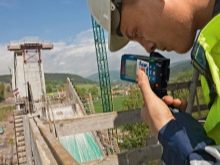
The principle of operation of the device is quite simple and consists in the following: the laser signal, emitted by the emitter, reaches the target object, reflects from it and returns back. The device, knowing the speed of the signal, fixes the time during which it covered a particular distance, after which it automatically calculates the distance to the object. The rangefinder is powered by a battery, which makes the instrument completely autonomous and allows you to use it in the field.

Views
Classification of laser rangefinders is made according to criteria such as functionality and principle of operation. In terms of functionality, the devices are divided into three groups, the first of which is represented by simple models with a range of up to 30 meters. Such samples belong to the category of household tools and are used for private construction and small measurements. The advantages of household models are low cost and ease of use.
The disadvantages include the inability to work with long distances and the inability to measure the angles of inclination.

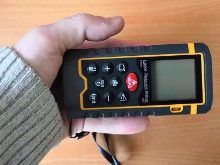

The second group is the most numerous and is represented by devices with a range of up to 80 m. The devices are equipped with a standard set of functions, including the ability to add and subtract, find the area and volume, as well as the option to change units of measurement, memory of the last values, screen backlight and sound. Some models are capable of working with two or more reference points and are equipped with a timer. The main advantage of middle class devices is their versatility. The disadvantages include the inability to work with long distances and the inability to measure the angles of inclination.
This allows you to use rangefinders both for professional activities and for work at home.



The pluses also include an acceptable cost, a wide range of models, simple and intuitive operation and a long service life of the devices. As for the minuses, there are no particular flaws in the models of this group. The exception is the complaints of individual users about the impossibility of measuring angles and complex curved structures.
However, such claims can be considered subjective, since devices of a completely different class are required to perform such work.


The third group includes high-tech samples that, in addition to the above functions, are capable of performing complex mathematical calculations., determine the dimensions of inaccessible elements, calculate the length of curved lines, calculate the areas of triangles, numerical values of angles and determine the coordinates of specified points. Such rangefinders are capable of working at distances from 100 to 300 m, are equipped with a built-in video camera or an optical sight and, thanks to the powerful display backlight, can be used in the dark.The advantages of the samples include multifunctionality, modern design and a large number of additional functions. The disadvantage is the high cost of the models, which is understandable by the wide range of their capabilities and excellent working qualities.
The next sign of the classification of laser rangefinders is the principle of operation of the devices. According to this criterion, impulsive and phase patterns are distinguished.


Impulsive
Rangefinders of this type include an emitting detector and a pulsed laser. In order to calculate the distance to a given point, he multiplies the travel time of the wave by the speed of light. Thanks to the powerful impulse, the models are able to operate at fairly large distances (from 1 km) and are often installed on military sights. A distinctive feature of impulsive rangefinders is a short light "shot" and low sensitivity to signal interruption, which allows them to work effectively under the influence of adverse environmental factors, for example, with a large traffic flow, rain or crosswind



Phase
Such rangefinders, unlike the previous type, are not capable of working at long distances, however, they are characterized by high measurement accuracy and are much cheaper than impulsive counterparts. The latter is due to the lack of an expensive, highly accurate timer, which is supplied with pulse samples. The principle of operation of phase rangefinders is that the laser beam goes to an object with one phase, then is reflected and goes backwards with another. The device at this time takes into account the phase shift and determines the range of the object.
The two-phase wave trajectory allows the device to calculate distances with extreme accuracy, which makes phase models the most popular type of measuring equipment. If the object is at a distance that exceeds the wavelength, the laser sends a signal several times with different modulation frequencies. Further, a microprocessor is switched on, which solves a system of linear equations and calculates the distance to the object with special accuracy. The measurement error of the phase models is +/- 0.5 mm, the operating range does not exceed 1 km.
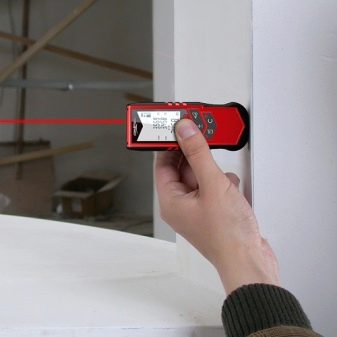

What to look for when choosing?
Before you start choosing a laser tape measure, you need to decide on the conditions in which it is supposed to be used. So, if you can choose absolutely any model of average functionality for indoor use, then for outdoor use it is recommended to take a device with a sight. This is due to the fact that outdoors, even from a distance of 10-15 meters, it is almost impossible to see, and even more so fix a given point. Built-in sightings, in turn, are optical and digital.


Optical models are an earlier version of the devices and are not so common at this time. Such samples have, as a rule, 2x magnification, which allows you to fairly accurately correct the direction of the beam and measure according to all the rules. A significant disadvantage of optical sighting devices is the need to use a tripod, since keeping the rangefinder on the weight and looking through the peephole, it is quite difficult to clearly fix the crosshair of the sight at the desired point.
Therefore, if finances allow, it is better to choose a rangefinder with a digital sight, which is a built-in zoom camera that displays an image on the screen. In order to mark a point on a distant surface, you just need to align it with the crosshair of the display and take a measurement. Digital models are much more convenient than optical ones and have 4x magnification. This allows you to easily take measurements in hard-to-reach and inconvenient places, for example, at floor level: it is extremely inconvenient to look through the peephole in such cases, and it will not be difficult to find and mark a point on the display screen.


The next selection criterion is the measuring range.And if everything is simple with the maximum value and everyone chooses a model in accordance with the nature of the upcoming work, then not so often they pay attention to the minimum measurement distance. This approach is fundamentally wrong, since situations often arise when it is necessary to measure a narrow space or determine the size of a structural element. Therefore, it is better to choose a device that can read distances from 5 cm.In fairness, it should be noted that most models work in this range, however there are many devices measuring from 50 cm.At the same time, there is absolutely no difference in price between the first and the second, in connection with which it is better to choose a rangefinder with a wider operating range.
Another important selection criterion is the measurement accuracy. The bulk of devices in the middle price category (up to 6,000 rubles) have an error of 1.5 to 3 mm, while for more expensive options this indicator barely reaches 1 mm. However, these values are not constant and depend on sunlight, immobility of the rangefinder during operation and the distance of the object. So, with an increase in the distance between two points, the error will increase, and vice versa.


Also, when choosing a model, you should pay attention to the availability of additional functions. So, the tracking option will allow you to continuously measure distances while moving the rangefinder, and then show the results. This option is necessary in cases when it is required to measure part of the room or the length of the overall structure. Another useful option is the ability to measure angles. Products with a goniometer are necessary for the construction of roofs and the measurement of curved foundations. If you plan to perform multiple geometric calculations using formulas for calculating the area, angles and volume, then you need to purchase a model with a strong microprocessor and good software.
For work in the field, as well as for outdoor measurements, it is recommended to choose rangefinders with a tripod, while for indoor work, it will be enough to place the device on a table or the floor, and there is no need to purchase a tripod. And a final tip: when buying a laser rangefinder, it is better to opt for models that run on batteries. This is due to the fact that when purchasing a product with a built-in battery, when the working life is developed, it may be difficult to replace it.


How to use it correctly?
In order to work with the laser rangefinder not cause difficulties and bring the desired result, a number of recommendations should be followed.
- Before using the tape measure, you need to carefully read the instructions.
- Protect the device from moisture and dirt, and avoid excessive overheating or cooling.
- Despite the presence of protective pads on the body, not all models of laser rangefinders are shockproof, and can break if severe weight loads occur. In this regard, they should be operated carefully, trying to avoid accidental falls.
- It is forbidden to let children play with the device or direct the laser beam at people or animals.
- Elimination of faults should be carried out only in repair shops specializing in the repair of high-precision measuring equipment. It is not recommended to open and repair the device yourself.
- It is necessary to store the laser rangefinder in a special case, away from heating devices and direct sunlight.


After the basic rules of operation are taken into account, you can start measuring spaces. To do this, you should adhere to a certain algorithm of actions, which includes several sequential operations.
- The first step is to remove the rangefinder from the case, mount it on a tripod, or place it on a flat surface.
- Then, using the start button, the device is turned on and a reference point is selected, which can be determined both on the front of the rangefinder and on the back. This function allows you to ignore the thickness of the case when measuring and make measurements more accurately.
- After selecting the reference point, set the units of measurement in which the measurement will be made, and press the signal or pulse button.
- The measurement results, as well as the required area and volume calculations, are immediately shown on the display.
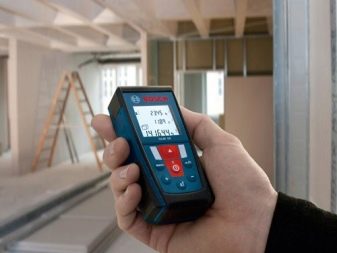

Popular models rating
The modern market of measuring equipment presents a wide range of laser rangefinders. Below is an overview of the most popular models, reviews of which can be seen on the Internet most often.
- German Laser Rangefinder Tape equipped with a waterproof case and a memory that stores information about the last 20 measurements. The device can withstand drops from a 10-meter height and is capable of operating at air temperatures from -30 to 55 degrees and humidity up to 98%. The model is distinguished by high measurement accuracy and has an error of no more than 2 mm. The software allows you to determine the height of structures from a distance, using the Pythagorean formula, and the ability to work with obstacles makes it possible to measure through obstacles. The model is equipped with a backlight, a four-line liquid crystal display and a high-precision powerful laser, and the calculation time for the required parameters does not exceed 2 seconds. The cost of the tool is 5200 rubles.
- Model of the German brand Stabila LD 420 Set 18378 produced in Hungary and costs 15,880 rubles. The device is designed to work with long distances and belongs to the category of a professional tool. The rangefinder fully complies with stringent international requirements, is manufactured in accordance with the ISO 16331-1 standard, has a dust and moisture resistant housing and is not afraid of falls from a height. The device operates on two AAA batteries with a voltage of 1.5 V, its weight is 150 g, the dimensions of length, width and height are 155x80x220 mm.


- Remote laser model Hilti PD-E Equipped with an LED display, images on which are clearly visible even in bright sunlight. The device is equipped with a sensor capable of measuring the angle of inclination up to 360 degrees, which makes it possible to use it as a protractor. The product is also equipped with a viewfinder and can be used outdoors. The error is 1 mm, the measurement range is up to 200 m, the protection class is IP 65. The model is equipped with a class 2 laser with a power of up to 1 mW, is capable of operating in the temperature range from -10 to 50 degrees and is produced in dimensions of 129x60x28 mm. Alkaline batteries are enough for 5,000 measurements, the device weighs 200 g and costs 24,000 rubles.
- Chinese assembly model Instrumax Sniper 50 IM0107 manufactured in accordance with the IP54 standard and equipped with a laser diode with a wavelength of 650 nm, capable of operating at distances of up to 50 m.The liquid crystal display is equipped with bright backlighting, the weight of the device is 115 g, and three AAA batteries with a voltage of 1.5 are used as a power source B. The range finder has two reference points, weighs 250 g, is manufactured in dimensions of 174x126x66 mm and costs 3,159 rubles.


- Japanese-made Makita LD050P laser rangefinder is designed to measure distances with a distance of up to 40 meters, but in the presence of a reflector, the range increases to 50. The built-in microprocessor is capable of adding and subtracting distances, as well as calculating the area and storing the last 5 results in memory. The device is powered by two AAA batteries with a voltage of 1.5 V, has 2 reference points and weighs 260 g. The model is not suitable for work with a tripod and does not have a sight, which is why it belongs to the category of a non-professional tool and is perfect for home use. The device is available in sizes 180x130x65 mm and costs 5,519 rubles.
- Model of the American brand Dewalt DW 03050 produced in Hungary, designed for repair and construction work and is capable of taking measurements at a distance of up to 50 m.The microprocessor can perform all the standard set of calculations, store the last 5 results in memory and make measurements in both metric and imperial systems. The product complies with the IP65 protection class, due to which it does not allow dust to enter the housing and can be used in the rain. The device weighs 280 g, runs on two AAA batteries, is available in dimensions of 180x126x75 mm and costs 6,925 rubles.
- Tesla M-40 Touch Laser Rangefinder is capable of operating in the range from 20 to 40 m, operates on AAA batteries and has an error of 2 mm. The device can be operated at temperatures from 0 to 40 degrees, is equipped with a class 2 laser with a wavelength of 630 nm and is intended for home use. The cost of the device is 2,550 rubles.



For information on when a laser range meter is used, see the video below.












The comment was sent successfully.